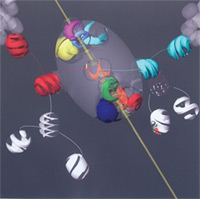 |
|||||||||||
|
|||||||||||
|
|||||||||||
|
At a time when the Large Hadron Collider is scheduled to start up in 2007 and the Tevatron at Fermilab will shut down by the end of this decade, the particle physics program in the United States is at a crossroads. Should the United States fold its cards and determine that the field of particle physics has lost its steam? Or should the United States step up to the plate and prepare to submit a bid to host the next-generation particle accelerator? These are the questions that the National Academies’ National Research Council charged the Committee on Elementary Particle Physics in the 21st century (EPP2010) to answer, asking the 22-member panel to lay out a 15-year plan. Yesterday on 26 April in the National Academies’ Keck Center in Washington D.C., EPP2010 launched their much-anticipated report, "Revealing the Hidden Nature of Space and Time – Charting the Course for Elementary Particle Physics." Outlined in priority order as designated by EPP2010, the report recommends that the U.S.:
At the launch, EPP2010 Chair Harold Shapiro described how the committee reached their recommendations for the future of particle physics in the United States. "We began our journey by trying to understand if particle physics remained compelling," Shapiro said. "Was it going on to bigger and better things or had it run out of steam? We came to the conclusion that this might be the most exciting moment in a generation. Exploring the Terascale and having the technology to do it is more compelling than ever." Shapiro explained that having satisfied themselves with answering the question whether particle physics has a compelling reason to continue, the committee went on to examine the current U.S. program and found themselves very sobered by the lack of a future program . "Our committee came to a single overriding recommendation," he said. "The United States should remain globally competitive in elementary particle physics by playing a leading role in the worldwide effort to aggressively study the Terascale. Indeed the committee believes that only a strategy that includes an important accelerator-based component to exploit the Terascale can sustain distinction of the U.S. program." Consisting of both physicists and non-physicists, the EPP2010 Committee was an experiment for the National Academies’ National Research Council. Physicists on the panel faced the challenge of making compelling and understandable arguments for why the U.S. should seize the opportunity to host the next-generation particle accelerator. "It was a tremendous intellectual challenge to learn how to communicate with people who are not particle physicists," said EPP2010 Vice-Chair Sally Dawson. "It made us really hone our arguments. It was fun." With the launch of the report, it appears that the National Academies’ experiment is a success. "I’m very proud that we were able to identify these priorities," Shapiro said. "I would take a lot of pride in building a next-generation baby that our future students can use."The complete report and press release are available to download below. Download Report (pdf) |
|||||||||||
| © International Linear Collider |
